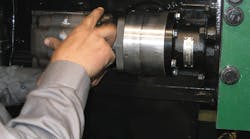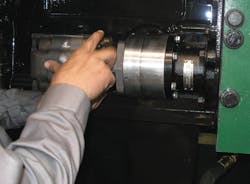How do you start a 5000-in.3 diesel engine with a starter not much bigger than the one in a standard SUV? With hydraulics, of course. Hydraulic starters work pretty much the same as those in passenger cars — a solenoid extends the starter’s spur gear forward to mesh with gear teeth on the engine’s flywheel, and the motor shaft rotates to crank the engine.
The main difference between hydraulic and electric starters is that hydraulic starters use a hydraulic motor for cranking power instead of an electric motor. The hydraulic starters feature all the advantages inherent to hydraulics:
• high power density, so hydraulics can transmit more power from a package much smaller than an electric motor,
• high tolerance to contamination, shock, vibration, and temperature extremes, and volatile vapors, and
• no heat buildup.
SA Industries, Stafford, Texas, manufactures hydraulic starters used primarily to start Caterpillar, Cummins and Detroit Diesel engines used in hydraulic fracturing and other applications. Theron Morrow, director of marketing, explains, “The starter consists of a hydraulic gear motor and a starter adapter, which mates the hydraulic motor to the engine flywheel. The adapter contains a friction-clutch inertia drive and drive shaft mechanism capable of withstanding the extreme usage demands of the fracturing environment.”
A starter course
SA manufactures the adapter and can provide a complete starter assembly, or customers can provide their own motor. Morrow continues, “We supply the starter adapter with an SAE 3 SAE 1 flange. This is advantageous in the case of repair or maintenance because the adapter takes the brunt of the starting punishment, and it can be replaced without the cost of replacing the motor.
“The starter adapters are designed with SAE specs in mind. Most are SAE B 4 bolt, 4.0-in. pilot, with SAE C 14-tooth splined shaft. Other configurations are available as well, including SAE B 2-bolt 4.00-in. pilot with SAE B 13 tooth spline and SAE A 2-bolt with 3¼-in. pilot.”
The starters operate at pressures of 1500-3000 psi and transmit torque to 200 lb-ft at speeds of 2000 to 3000 rpm. SA offers 11 different starters designed for engines with displacements from 200 to 5000 in.3 Whether supplied by the SA or the customer, the hydraulic gear motor is matched to meet the specific engine application.
For more information on hydraulic or pneumatic starters, contact Theron Morrow at (888) 558-7939 or visit www.saindustriesonline.com


